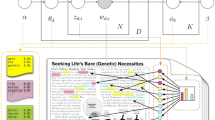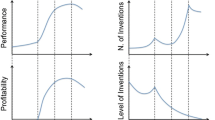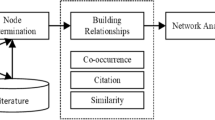Abstract
The increasing importance of technology foresight has simultaneously raised the significance of methods that determine crucial areas and technologies. However, qualitative and quantitative methods have shortcomings. The former involve high costs and many limitations, while the latter lack expert experience. Intelligent knowledge management emphasizes human–machine integration, which combines the advantages of expert experience and data mining. Thus, we proposed a new technology foresight method based on intelligent knowledge management. This method constructs a technological online platform to increase the number of participating experts. A secondary mining is performed on the results of patent analysis and bibliometrics. Thus, forward-looking, innovative, and disruptive areas and relevant experts must be discovered through the following comprehensive process: Topic acquisition → topic delivery → topic monitoring → topic guidance → topic reclamation → topic sorting → topic evolution → topic conforming → expert recommendation.
Similar content being viewed by others
References
Abraham B P, Moitra S D (2001). Innovation assessment through patent analysis. Technovation, 21(4): 245–252
Anand S S, Bell D A, Hughes J G (1996). EDM: A general framework for data mining based on evidence theory. Data & Knowledge Engineering, 18(3): 189–223
Antonio A L, Chang M J, Hakuta K, Kenny D A, Levin S, Milem J F (2004). Effects of racial diversity on complex thinking in college students. Psychological Science, 15(8): 507–510
Bai G Z, Zheng Y R, Wu X N, Jin J B, Liu Q Y (2017). Research and demonstration on forecasting method of disruptive technology based on literature knowledge correlation. Journal of Intelligence, 36(9): 38–44 (in Chinese)
Bang D, Frith C D (2017). Making better decisions in groups. Royal Society Open Science, 4(8): 170193
Brockhoff K K (2002). Indicators of firm patent activities. In: Technology Management: The New International Language. IEEE, 476–481
Cao L (2010). Domain-driven data mining: Challenges and prospects. IEEE Transactions on Knowledge and Data Engineering, 22(6): 755–769
Cascini L, Fornaro G, Peduto D (2009). Analysis at medium scale of low-resolution DInSAR data in slow-moving landslide-affected areas. ISPRS Journal of Photogrammetry and Remote Sensing, 64 (6): 598–611
Celiktas M S, Kocar G (2012). Foresight analysis of wind power in Turkey. International Journal of Energy Research, 36(6): 737–748
Courtney J F (2001). Decision making and knowledge management in inquiring organizations: Toward a new decision-making paradigm for DSS. Decision Support Systems, 31(1): 17–38
Czaplicka-Kolarz K, Stańczyk K, Kapusta K (2009). Technology foresight for a vision of energy sector development in Poland till 2030. Delphi survey as an element of technology foresighting. Technological Forecasting and Social Change, 76(3): 327–338
Davenport E, Cronin B (2000). The citation network as a prototype for representing trust in virtual environments. In: The Web of Knowledge: A Festschrift in Honor of Eugene Garfield. Medford, NJ: Information Today, 517–534
Drew S A W (2006). Building technology foresight: Using scenarios to embrace innovation. European Journal of Innovation Management, 9 (3): 241–257
Elgendy N, Elragal A (2014). Big data analytics: A literature review paper. In: Perner P, ed. Advance in Data Mining. Applications and Theoretical Aspects. ICDM 2014. Cham: Springer, 214–227
Fang W, Cao X W, Gao X W (2017). Technology forecasting and foresight: Concepts, methods, and practices. Global Science, Technology and Economy Outlook, 32(3): 46–53 (in Chinese)
Georghiou L G, Halfpenny P (1996). Equipping researchers for the future. Nature, 383(6602): 663–664
Grupp H, Linstone H A (1999). National technology foresight activities around the globe: Resurrection and new paradigms. Technological Forecasting and Social Change, 60(1): 85–94
Halal W E (2013). Forecasting the technology revolution: Results and learnings from the TechCast project. Technological Forecasting and Social Change, 80(8): 1635–1643
Hong L, Page S E (2004). Groups of diverse problem solvers can outperform groups of high-ability problem solvers. Proceedings of the National Academy of Sciences of the United States of America, 101(46): 16385–16389
Hussain M, Tapinos E, Knight L (2017). Scenario-driven roadmapping for technology foresight. Technological Forecasting and Social Change, 124: 160–177
Jun S, Park S, Jang D (2015). A technology valuation model using quantitative patent analysis: A case study of technology transfer in big data marketing. Emerging Markets Finance & Trade, 51(5): 963–974
Kanama D (2013). Development of technology foresight: Integration of technology roadmapping and the Delphi Method. In: Moehrle M G, Isenmann R, Phaal R, eds. Technology Roadmapping for Strategy and Innovation. Berlin, Heidelberg: Springer, 151–171
Karlsen J E (2014). Design and application for a replicable foresight methodology bridging quantitative and qualitative expert data. European Journal of Futures Research, 2(1): 40
Katsikopoulos K V, King A J (2010). Swarm intelligence in animal groups: When can a collective out-perform an expert? PLoS One, 5 (11): e15505
Liang S, Ji X T, Li Y (2015). Application of patent scientometrics methods in technology foresight—Take the new energy automobile as an example. Journal of Intelligence, 34(2): 73–78 (in Chinese)
Liang S, Li Z F (2017). Shaping the future: The possibility and reliability of technology foresight. Studies in Dialectics of Nature, 33(7): 25–30 (in Chinese)
Liu Y F, Zhou Y, Liao L (2016). Application of big data analysis method in technology foresight for strategic emerging industries. Strategic Study of CAE, 18(4): 121–128 (in Chinese)
Loyd D L, Wang C S, Phillips K W, Lount Jr R B (2013). Social category diversity promotes premeeting elaboration: The role of relationship focus. Organization Science, 24(3): 757–772
Luan J (2002). Data mining and knowledge management in higher education, potential applications. In: Workshop Associate of International Conference. Toronto: 1–18
Magruk A (2011). Innovative classification of technology foresight methods. Technological and Economic Development of Economy, 17 (4): 700–715
Martin B R, Johnston R (1999). Technology foresight for wiring up the national innovation system: Experiences in Britain, Australia, and New Zealand. Technological Forecasting and Social Change, 60(1): 37–54
McGarry K (2005). A survey of interestingness measures for knowledge discovery. Knowledge Engineering Review, 20(1): 39–61
Murry Jr J W, Hammons J O (1995). Delphi: A versatile methodology for conducting qualitative research. The Review of Higher Education, 18(4): 423–436
Nonaka I, Toyama R, Konno N (2001). SECI, Ba, and leadership: A unified model of dynamic knowledge creation. Long Range Planning, 33(1): 5–34
Østergaard C R, Timmermans B, Kristinsson K (2011). Does a different view create something new? The effect of employee diversity on innovation. Research Policy, 40(3): 500–509
Pietrobelli C, Puppato F (2016). Technology foresight and industrial strategy. Technological Forecasting and Social Change, 110(3): 117–125
Qiao Y (2013). Application of patent bibliometrics methods in technology foresight—Take the subsection of metallurgy as an example. Journal of Intelligence, 32(4): 34–37 + 27 (in Chinese)
Ren H Y, Yu L T, Wang F F (2016). Hotpots and trends of technology foresight research at home and abroad. Journal of Intelligence, 35(2): 81–87 + 115 (in Chinese)
Schaeffer G J, Uyterlinde M A (1998). Fuel cell adventures. Dynamics of a technological community in a quasi-market of technological options. Journal of Power Sources, 71(1–2): 256–263
Shin K S, Han I (2001). A case-based approach using inductive indexing for corporate bond rating. Decision Support Systems, 32(1): 41–52
Spinosa L M, Quandt C O, Ramos M P (2002). Toward a knowledge-based framework to foster innovation in networked organisations. In: The 7th International Conference on Computer Supported Cooperative Work in Design. IEEE, 308–313
Stiles E, Cui X (2010). Workings of collective intelligence within open source communities. In: International Conference on Social Computing, Behavioral Modeling, and Prediction. Berlin, Heidelberg: Springer, 282–289
Takahashi S, Owan H, Tsuru T, Uehara K (2014). Multitasking incentives and biases in subjective performance evaluation. Technical Report. Kunitachi, Japan: Institute of Economic Research, Hitotsu-bashi University
Thorleuchter D, Van den Poel D (2013). Web mining based extraction of problem solution ideas. Expert Systems with Applications, 40(10): 3961–3969
Tichy G (2004). The over-optimism among experts in assessment and foresight. Technological Forecasting and Social Change, 71(4): 341–363
Wack P (2017). Shooting the rapids. Historical Evolution of Strategic Management, I and II(1): 121
Wang Z L, Guan Q, Lan J (2015). Bibliometric analysis of domestic technology foresight research. Journal of Modern Information, 35(4): 98–101 + 107 (in Chinese)
Wells W, Spence-Stone R, Moriarty S, Burnett J (2008). Advertising Principles and Practice. Australian ed. Sydney, Australia: Pearson Education
Willyard C H, McClees C W (1987). Motorola’s technology roadmap process. Research Management, 30(5): 13–19
Yoon J P, Kerschberg L (1993). A framework for knowledge discovery and evolution in databases. IEEE Transactions on Knowledge and Data Engineering, 5(6): 973–979
Zhang F, Kuang Y (2016). The implementation and enlightenment of Japan’s 10th science and technology foresight. Journal of Intelligence, 35(12): 12–15 + 11 (in Chinese)
Zhang L, Li J, Shi Y, Liu X (2009a). Foundations of intelligent knowledge management. Human Systems Management, 28(4): 145–161
Zhang L L, Li J, Li A H, Zhang P, Nie G L, Shi Y (2009b). A new research field: Intelligent knowledge management. In: 2009 International Conference on Business Intelligence and Financial Engineering. IEEE, 450–454
Zhang L, Li J, Zhang Q, Meng F, Teng W (2019a). Domain knowledge-based link prediction in customer-product bipartite graph for product recommendation. International Journal of Information Technology & Decision Making (IJITDM), 18(1): 311–338
Zhang L, Zhao M, Feng Z (2019b). Research on knowledge discovery and stock forecasting of financial news based on domain ontology. International Journal of Information Technology & Decision Making (IJITDM), 18(3): 953–979
Zhang L L, Zhao M H, Wang Q (2016). Research on knowledge sharing and transfer in remanufacturing engineering management based on SECI model. Frontiers of Engineering Management, 3(2): 136–143
Zhao M H, Zhang L L, Zhang L B, Wang F (2018). Research on technology foresight method based on intelligent convergence in open network environment. In: International Conference on Computational Science. Cham: Springer, 737–747
Zhou Y, Liu H L, Liao L, Xue L (2017). Literature review of quantitative technology foresight methods based on topic modeling. Science and Technology Management Research, 37(11): 185–196 (in Chinese)
Author information
Authors and Affiliations
Corresponding author
Additional information
The work is supported by the National Natural Science Foundation of China (Grant Nos. 71471169, 91546201 and 71071151).
Rights and permissions
About this article
Cite this article
Zhang, L., Huang, S. New technology foresight method based on intelligent knowledge management. Front. Eng. Manag. 7, 238–247 (2020). https://doi.org/10.1007/s42524-019-0062-z
Received:
Accepted:
Published:
Issue Date:
DOI: https://doi.org/10.1007/s42524-019-0062-z




